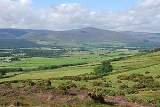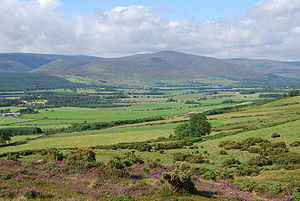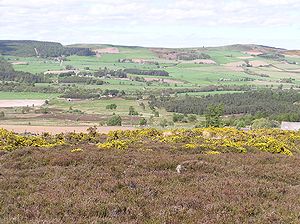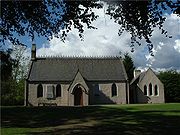
Finzean
Encyclopedia

Community council
A community council is a public representative body in Great Britain.In England they may be statutory parish councils by another name, under the Local Government and Public Involvement in Health Act 2007, or they may be non-statutory bodies...
area and former ecclesiastical parish, which forms the southern part of the Parish of Birse
Birse
Birse is a parish in the Lower Deeside area of Aberdeenshire, Scotland, which includes the communities of Finzean and Ballogie. However the name Birse is often used to refer only to the northwestern part of the parish which lies on the south side of the River Dee, Aberdeenshire, opposite the...
, Aberdeenshire
Aberdeenshire
Aberdeenshire is one of the 32 unitary council areas in Scotland and a lieutenancy area.The present day Aberdeenshire council area does not include the City of Aberdeen, now a separate council area, from which its name derives. Together, the modern council area and the city formed historic...
, Scotland
Scotland
Scotland is a country that is part of the United Kingdom. Occupying the northern third of the island of Great Britain, it shares a border with England to the south and is bounded by the North Sea to the east, the Atlantic Ocean to the north and west, and the North Channel and Irish Sea to the...
. Finzean was the subject of many well-known landscape paintings by the artist Joseph Farquharson
Joseph Farquharson
Joseph Farquharson DL was a Scottish painter, chiefly of landscapes. He is most famous for his snowy winter landscapes, often featuring sheep and often depicting dawn or dusk...
, whose family have owned Finzean Estate (which occupies the eastern half of Finzean) since the 17th century. Finzean extends to approximately 8000 hectares in area and had a population of approximately 270 in 2002 .
Geographical extent
Finzean occupies the upper catchmentDrainage basin
A drainage basin is an extent or an area of land where surface water from rain and melting snow or ice converges to a single point, usually the exit of the basin, where the waters join another waterbody, such as a river, lake, reservoir, estuary, wetland, sea, or ocean...
of the Water of Feugh
Water of Feugh
The Water of Feugh is a stream in Aberdeenshire that is the largest tributary to the River Dee. This stream rises in the Grampian Mountains of Scotland, in an area known as the Forest of Birse, and has a particularly scenic aspect in a series of cascades at the Bridge of Feugh slightly above its...
within the area of the Lower Deeside
Lower Deeside
Lower Deeside is a region along the River Dee in Aberdeenshire, Scotland. The boundaries of this area are subject to interpretation, since the usage has altered through historic times; however, the area is generally associated with the communities of Durris, Maryculter and Banchory-Devenick in the...
, the main tributary of the River Dee
River Dee, Aberdeenshire
The River Dee is a river in Aberdeenshire, Scotland. It rises in the Cairngorms and flows through Strathdee to reach the North Sea at Aberdeen...
. The southern boundary of Finzean is the old county boundary between Aberdeenshire
Aberdeenshire (historic)
Aberdeenshire or the County of Aberdeen is a registration county of Scotland. This area is also a lieutenancy area.Until 1975 Aberdeenshire was one of the counties of Scotland, governed by a county council from 1890...
and Kincardineshire
Kincardineshire
The County of Kincardine, also known as Kincardineshire or The Mearns was a local government county on the coast of northeast Scotland...
which follows the Water of Aven
Water of Aven
The Water of Aven is a tributary of the Water of Feugh, itself the largest tributary of the River Dee, Aberdeenshire, Scotland. The Water of Aven rises at Loch Tennet, where the historic counties of Aberdeenshire, Angus and Kincardineshire meet and flows for approximately 15km to its confluence...
(or A'an) from Loch Tennet to the Feughside Inn at Whitestone. The eastern boundary varies slightly between historic parish boundaries and modern-day polling district boundaries, but generally follows the route of the minor road north from Whitestone towards Potarch. The northern boundary of Finzean follows the watershed separating the Feugh catchment from the Burn of Cattie, although it runs slightly to the north of this ridge in the eastern part of the parish, crossing the B976 at Berrysloch. The western boundary of Finzean is the watershed separating the Feugh from Glen Tanar and Glen Esk .
The sparsely populated western half of Finzean, in the higher reaches of the Feugh catchment, is known as the Forest of Birse
Forest of Birse
The Forest of Birse is the name given to a remote upland area in the upper catchment of the Water of Feugh, which forms the south-western portion of the Parish of Birse, Aberdeenshire, Scotland...
and does not form part of the Finzean Estate owned by the Farquharson family. The boundary between the Forest of Birse and Finzean Estate is formed by two small tributaries of the Feugh: the Finlets Burn and the Laird's Burn.
Landscape and natural heritage

To the south and west, Finzean is shielded by higher granite
Granite
Granite is a common and widely occurring type of intrusive, felsic, igneous rock. Granite usually has a medium- to coarse-grained texture. Occasionally some individual crystals are larger than the groundmass, in which case the texture is known as porphyritic. A granitic rock with a porphyritic...
hills which rise to more than 500 metres above sea level. Notable hills which are prominent in views to the south and west include Clachnaben
Clachnaben
Clachnaben is a 589-metre hill in Glen Dye, Aberdeenshire, Scotland. It is a distinctive hill visible from many points on Lower Deeside and is topped with a large granite tor....
(589 m), which lies outside Finzean, and Peter Hill (617 m), which is the most prominent hill in Finzean (although Gannoch, in the Forest of Birse, is higher at 731 metres). The hills are mostly covered with heather
Calluna
Calluna vulgaris is the sole species in the genus Calluna in the family Ericaceae. It is a low-growing perennial shrub growing to tall, or rarely to and taller, and is found widely in Europe and Asia Minor on acidic soils in open sunny situations and in moderate shade...
, but along their lower slopes, there are some extensive areas of forestry
Forestry
Forestry is the interdisciplinary profession embracing the science, art, and craft of creating, managing, using, and conserving forests and associated resources in a sustainable manner to meet desired goals, needs, and values for human benefit. Forestry is practiced in plantations and natural stands...
, most of which is planted with Scots Pine
Scots Pine
Pinus sylvestris, commonly known as the Scots Pine, is a species of pine native to Europe and Asia, ranging from Scotland, Ireland and Portugal in the west, east to eastern Siberia, south to the Caucasus Mountains, and as far north as well inside the Arctic Circle in Scandinavia...
and Larch
Larch
Larches are conifers in the genus Larix, in the family Pinaceae. Growing from 15 to 50m tall, they are native to much of the cooler temperate northern hemisphere, on lowlands in the north and high on mountains further south...
. There is also a small area of natural pine forest at Glenferrick and Finlets, which is the most easterly remnant of the ancient Caledonian Forest
Caledonian Forest
The Caledonian Forest is the name of a type of woodland that once covered vast areas of Scotland. Today, however, only 1% of the original forest survives, covering in 84 locations. The forests are home to a wide variety of wildlife, much of which is not found elsewhere in the British...
.
The Twin Trees of Finzean are a natural curiosity that are well known locally and have been included in the Forestry Commission
Forestry Commission
The Forestry Commission is a non-ministerial government department responsible for forestry in Great Britain. Its mission is to protect and expand Britain's forests and woodlands and increase their value to society and the environment....
's Heritage Trees of Scotland. The trees are about 100 years old and a branch from one has naturally grafted
Grafting
Grafting is a horticultural technique whereby tissues from one plant are inserted into those of another so that the two sets of vascular tissues may join together. This vascular joining is called inosculation...
itself on to its neighbour, joining the two together in a natural arch that featured on old postcards of the area.
The Water of Feugh and the lower part of the Water of Aven are both designated as part of the River Dee Special Area of Conservation
Special Area of Conservation
A Special Area of Conservation is defined in the European Union's Habitats Directive , also known as the Directive on the Conservation of Natural Habitats and of Wild Fauna and Flora...
due to their importance for populations of Atlantic Salmon
Atlantic salmon
The Atlantic salmon is a species of fish in the family Salmonidae, which is found in the northern Atlantic Ocean and in rivers that flow into the north Atlantic and the north Pacific....
and Eurasian Otter .
History and cultural heritage

Mesolithic
The Mesolithic is an archaeological concept used to refer to certain groups of archaeological cultures defined as falling between the Paleolithic and the Neolithic....
era 8000 years ago. The first farmers settled during the neolithic
Neolithic
The Neolithic Age, Era, or Period, or New Stone Age, was a period in the development of human technology, beginning about 9500 BC in some parts of the Middle East, and later in other parts of the world. It is traditionally considered as the last part of the Stone Age...
period about 6000 years ago. Evidence of the neolithic settlers can be seen in the remains of Finzean House Long Cairn, one of two Scheduled Ancient Monuments in Finzean ; the other being the Ballochan hut-circles in the Forest of Birse, which dates from the late bronze age
Bronze Age
The Bronze Age is a period characterized by the use of copper and its alloy bronze as the chief hard materials in the manufacture of some implements and weapons. Chronologically, it stands between the Stone Age and Iron Age...
or early Iron Age
British Iron Age
The British Iron Age is a conventional name used in the archaeology of Great Britain, referring to the prehistoric and protohistoric phases of the Iron-Age culture of the main island and the smaller islands, typically excluding prehistoric Ireland, and which had an independent Iron Age culture of...
, between 2000–3000 years ago. Another well-known monument in Finzean is the Dardanus Stone, which lies alongside the B976 road at Corsedardar. This standing stone was uncovered at the end of the 18th century and has been held together by iron bars since being broken in two by workmen in about 1850. The stone is alleged to commemorate a mythical Scottish king called Dardanus, who reigned in the 1st century AD according to the writer Hector Boece
Hector Boece
Hector Boece , known in Latin as Hector Boecius or Boethius, was a Scottish philosopher and first Principal of King's College in Aberdeen, a predecessor of the University of Aberdeen.-Biography:He was born in Dundee where he attended school...
. In reality it is more likely to be a bronze age monument left by the Beaker people
Beaker culture
The Bell-Beaker culture , ca. 2400 – 1800 BC, is the term for a widely scattered cultural phenomenon of prehistoric western Europe starting in the late Neolithic or Chalcolithic running into the early Bronze Age...
In the 10th century the lands of Finzean became the personal property of the King of Scots, who used the Forest of Birse as a hunting reserve. In the 12th century King William the Lion
William I of Scotland
William the Lion , sometimes styled William I, also known by the nickname Garbh, "the Rough", reigned as King of the Scots from 1165 to 1214...
gifted the area to the Bishops of Aberdeen
Bishop of Aberdeen
The Bishop of Aberdeen was the ecclesiastical head of the Diocese of Aberdeen, one of Scotland's 13 medieval bishoprics, whose first recorded bishop is an early 12th century cleric named Nechtan...
who continued to own it until the 16th century, during which they gradually sold off all the land. During the 17th and 18th centuries, the Farquharson
Clan Farquharson
Clan Farquharson of Invercauld is a Highland Scottish clan. The clan hails from Aberdeenshire and is a member of the Chattan Confederation.-Origins:Farquhar - from the Gaelic 'fear' and 'char' meaning 'dear one'...
family acquired the whole of the eastern part of Finzean, while the Forest of Birse was owned by the Earl of Aboyne
Earl of Aboyne
Earl of Aboyne is a title in the Peerage of Scotland, borne in the Gordon family ....
, but with ancient common rights retained by all the inhabitants of Birse
Birse
Birse is a parish in the Lower Deeside area of Aberdeenshire, Scotland, which includes the communities of Finzean and Ballogie. However the name Birse is often used to refer only to the northwestern part of the parish which lies on the south side of the River Dee, Aberdeenshire, opposite the...
parish to this day.
Evidence of the rich later history of Finzean can be seen in the 17 listed buildings and monuments that have been designated in Finzean .
Category A Listed Buildings
Finzean Bucket Mill; Finzean Sawmill and Turning Mill
Category B Listed Buildings
Birse Castle; Easter Clune; Finzean Home Farm Steading; Mill of Clinter; Tillyfruskie
Category C Listed Buildings
Birse and Feughside Parish Kirk; Birse Castle Kennels; Birse War Memorial; Bridge over Hollow Burn; Finzean House; Finzean House South Lodge; Forest of Birse Kirk; Haughend Grain Kiln; Memorial well to Joseph Farquharson
Joseph Farquharson
Joseph Farquharson DL was a Scottish painter, chiefly of landscapes. He is most famous for his snowy winter landscapes, often featuring sheep and often depicting dawn or dusk...
; Mill of Clinter Cottage
The most important of these buildings are undoubtedly the three water-powered mills along the Water of Feugh which are owned and managed by Birse Community Trust
Development trust
Development Trusts are organisations which operate in the United Kingdom that are:*community based, owned and led*engaged in the economic, environmental and social regeneration of a defined area or community...
. These wooden buildings date from the 1850s but were restored to full working order in the 1980s .
Birse Castle, which is the only remaining castle in Finzean, dates from about 1600, was restored from a ruin in 1905, and was extensively refurbished in 1999 as the main Scottish home of Charles Pearson, brother of the 4th Viscount Cowdray
Viscount Cowdray
Viscount Cowdray, of Cowdray in the County of West Sussex, is a title in the Peerage of the United Kingdom. It was created in 1917 for the industrialist Weetman Pearson, 1st Baron Cowdray, head of the Pearson conglomerate...
and owner of Dunecht estate
Dunecht estate
The Dunecht Estate is one of the largest private estate in Aberdeenshire, Scotland at . It is owned by The Hon Charles Anthony Pearson, the younger son of the 3rd Viscount Cowdray...
, part of which is in the Forest of Birse.
Finzean in the 21st century
The second half of the 20th century saw declines in traditional rural industries in Finzean, as elsewhere. There are now only seven tenant farms in Finzean where there were nearly 20 in the 1950s, and Finzean estate's own farming operation now dominates much of the area. This decline was countered by the growing wealth generated by the advent of the North Sea OilNorth Sea oil
North Sea oil is a mixture of hydrocarbons, comprising liquid oil and natural gas, produced from oil reservoirs beneath the North Sea.In the oil industry, the term "North Sea" often includes areas such as the Norwegian Sea and the area known as "West of Shetland", "the Atlantic Frontier" or "the...
industry in the 1970s. This brought an influx of new people to the north-east of Scotland, and Finzean was no exception. Being an attractive location on Royal Deeside and within commuting distance of Aberdeen
Aberdeen
Aberdeen is Scotland's third most populous city, one of Scotland's 32 local government council areas and the United Kingdom's 25th most populous city, with an official population estimate of ....
, Finzean has become a desirable area in which to live. Although this has made houses less affordable for local families, an enlightened approach by the estate regarding the sale of building plots has helped to limit this effect.
Finzean is now a small but thriving community, with a primary school attended by about 50 children, a parish church that was extended and refurbished in 2005, an award-winning community hall that was rebuilt in 2003 and community woodlands that provide attractive walks for local residents. Apart from the farms and estates, local businesses include a shop and post office, a farm shop and tearoom, a furniture restorer and cabinetmaker, a shortbread
Shortbread
Shortbread is a type of unleavened biscuit which is traditionally made from one part white sugar, two parts butter, and three parts oatmeal flour. The use of plain white flour is common today, and other ingredients like ground rice or cornflour are sometimes added to alter the texture...
manufacturer and a number of building contractors and self-employed tradespeople
Tradesman
This article is about the skilled manual worker meaning of the term; for other uses see Tradesperson .A tradesman is a skilled manual worker in a particular trade or craft. Economically and socially, a tradesman's status is considered between a laborer and a professional, with a high degree of both...
.
The third meeting of the Rural Development Council
Rural Development Council
The Rural Development Council is an advisory body to the Scottish Cabinet Secretary for Rural Affairs and the Environment, Richard Lochhead MSP...
, chaired by Richard Lochhead
Richard Lochhead
Richard Neilson Lochhead is the Scottish Government's Cabinet Secretary for Rural Affairs and the Environment and the Scottish National Party Member of the Scottish Parliament for Moray.-Background and early career:...
MSP was held in Finzean village hall in December 2008.

